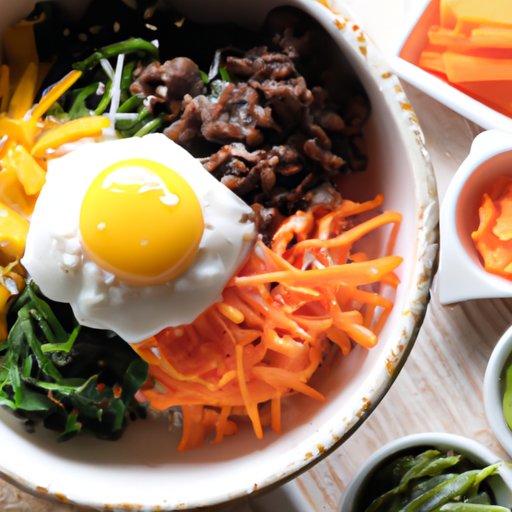Introduction
Bibimbap is a classic Korean dish that consists of steamed white rice topped with vegetables, meat, and an egg. It is a popular choice for those looking for an easy, delicious meal that offers a variety of flavors and textures. But is bibimbap healthy? In this article, we will explore the nutritional analysis of bibimbap dishes, the health benefits of eating bibimbap, a comparison of popular bibimbap recipes, and how to create a healthy bibimbap dish.
Nutritional Analysis of Bibimbap Dishes
The nutritional content of bibimbap depends on the ingredients used. A typical bibimbap dish contains around 500-700 calories per serving, with most of the calories coming from carbohydrates in the rice. The dish also contains some protein from the meat, vegetables, and egg, as well as fat from the sauces.
In terms of macronutrients, bibimbap typically contains around 20-30 grams of protein, 70-90 grams of carbohydrates, and 10-15 grams of fat per serving. It is also a good source of dietary fiber, which helps to keep you feeling full.
In terms of micronutrients, bibimbap is a good source of vitamins and minerals such as vitamin A, vitamin C, iron, and calcium. The vegetables and meat provide most of these essential nutrients.
Health Benefits of Eating Bibimbap
Eating bibimbap can provide a number of health benefits. The combination of carbohydrates, protein, and fat provides a balanced diet that can help to sustain energy levels throughout the day. The dish is also a good source of vitamins and minerals, which are essential for a healthy body.
Furthermore, bibimbap has been found to have probiotic potential due to the presence of lactic acid bacteria in the vegetables and sauces. This could help to support gut health and digestion.

Exploring the Ingredients in Bibimbap
Rice is the main ingredient in bibimbap, and it provides the majority of the calories and carbohydrates. White rice is typically used, though brown rice or other grains can be substituted for a healthier option.
Vegetables are an important part of bibimbap, providing vitamins, minerals, and dietary fiber. Commonly used vegetables include spinach, carrots, mushrooms, bell peppers, and bean sprouts.
Meat is also often included in bibimbap, usually in the form of beef, pork, or chicken. This adds flavor and protein to the dish.
Finally, sauces are used to add flavor and texture. The most common sauce used in bibimbap is gochujang, a spicy fermented red pepper paste. Soy sauce, sesame oil, and other seasonings are also commonly used.
A Comparison of Popular Bibimbap Recipes
There are many different types of bibimbap recipes, each with its own unique flavor and style. Here is a quick comparison of three popular recipes:
Korean Style: This is the traditional version of bibimbap, using white rice, vegetables, beef, and gochujang sauce.
Japanese Style: This version of bibimbap uses sushi rice, vegetables, and teriyaki sauce instead of gochujang.
American Style: This version of bibimbap uses brown rice, vegetables, chicken, and a ranch dressing-based sauce.

Examining the Health Claims Surrounding Bibimbap
Many people claim that bibimbap can help with weight loss, reduce inflammation, and improve heart health. However, these claims are not backed up by scientific evidence. While bibimbap can be a healthy and nutritious meal, it is not a miracle cure for any of these conditions.

Creating a Healthy Bibimbap Dish
If you want to make a healthier version of bibimbap, there are a few things to consider. Firstly, choose the right ingredients. Opt for whole grain rice, fresh vegetables, lean meat, and low sodium sauces. Secondly, add some extra protein to your dish, such as tofu or eggs. Thirdly, limit the amount of sodium you use in your sauces. Finally, experiment with different flavors and spices to find the perfect balance.
Conclusion
Bibimbap is a classic Korean dish that is both delicious and nutritious. It is a balanced meal that provides a good source of protein, carbohydrates, and vitamins and minerals. While there are no scientific studies to back up the health claims surrounding bibimbap, making some simple adjustments to the ingredients can make it even healthier. With the right ingredients and flavors, you can create a delicious, healthy bibimbap dish.
Final Thoughts
Bibimbap is a great way to enjoy a tasty, nutritious meal. By exploring the various ingredients and adjusting them to make a healthier version, you can create a dish that is sure to please everyone.
(Note: Is this article not meeting your expectations? Do you have knowledge or insights to share? Unlock new opportunities and expand your reach by joining our authors team. Click Registration to join us and share your expertise with our readers.)
